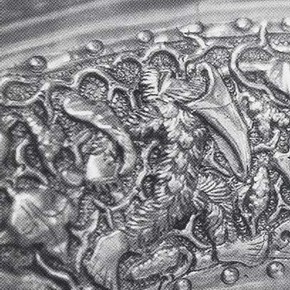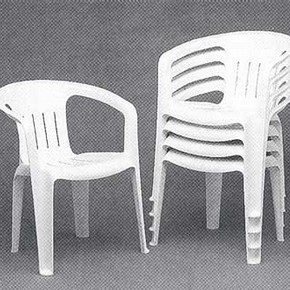Conservation Journal
April 1997 Issue 23
RCA/V&A Conservation Course Abstracts
The last issue of the Journal to include abstracts from student essays and research projects was April 1996 (number 19). The aim remains to provide a comprehensive collection, publishing a selection as space and opportunity allows. Here we present synopses of three major projects completed by students in their final year, together with some recent History of Design essays from first year students. Hopefully the abstracts continue to illustrate the diversity of specialisms embraced by the Course and the astounding range of subjects involved in the students' academic work.
Final Year Research Project Reports
Sonja Müller
Textiles Conservation
An investigation into detergents suitable for cellulose fibres in textiles conservation.
March 1996
14700 words
This research project is an investigation into detergents suitable for wet cleaning cellulosic objects in textile conservation. It outlines the wet cleaning process and some of the problems encountered when the process is used for cleaning historic textiles. The investigation focuses on the wet-cleaning of cellulose textiles and looks in particular at five different detergents currently used in various countries for textiles conservation. Standard soiled cotton samples were washed in a washing solution of each detergent, in a set of trials at different temperatures, durations and amounts of agitation. Their performance is examined in terms of soil removal power and prevention of soil redeposition using a spectrophotometer. The results are compared and their relevance for textile conservation is discussed. Of the tested detergents Synperonic N and Orvus WA removed the greatest amount of soil. Synperonic N is most suitable for cold washing solution, whereas Orvus WA achieves very good results in a washing solution of a higher temperature.
Merete Winness
Furniture Conservation
A feasibility study of the use of video microscopy for wood identification of furniture in situ.
March 1996
7868 words
The recent availability of portable video microscopes could encourage conservators and scientists to overcome the difficulties presented by in situ microscopy and help to reduce and refine sampling. The intention of this research was to conduct a feasibility study of the use of a portable video microscope for in situ wood identification of furniture. The project was carried out in two phases; testing the method under optimum conditions in the laboratory and secondly applying video microscopy in the museum galleries. Conclusions on the feasibility of using a portable video microscope for in situ wood identification of furniture were drawn based on these results.
Rachel Oliver
Ceramics and Glass Conservation
An investigation into the authenticity of four pieces of lajvardina ware in the Victoria and Albert Museum
March 1996
13966 words
For several decades four pieces of ceramics have been displayed in the Victoria and Albert Museum, London, as examples of the thirteenth century Persian ware called lajvardina. In recent years, however, doubts have arisen concerning the authenticity of these pieces. The aim of this project was to resolve these doubts. The occurrence of fakes and forgeries in the art world generally, and in Islamic pottery specifically, is outlined and then a brief history of ceramics in Persia, leading up to the manufacture of lajvardina ware, is given. Most of our knowledge about lajvardina ware comes from a treatise written in Persia in 1301AD by Abu'l-Qasim. The information contained in this treatise on the methods and materials used in its production are detailed in the report.
Having established the background of lajvardina ware, attention is turned to the four pieces in the V&A. Various analytical techniques, ranging from stylistic assessment and solvent tests, to thermoluminescence (TL) dating and Scanning Electron Microscopy (SEM), were applied to the suspect pieces and to a lajvardina tile fragment as an experimental control. The results of all the analyses are discussed and conclusions regarding the authenticity of the four lajvardina ceramics under investigation are drawn. Finally, possible future treatments of the pieces are examined and their ethics considered before a recommendation is given.
History of Art and Design Essays

Detail of object from investigation into the medieval role of the wild man (click image for larger version)
Sophia Shirley
Metals Conservation
An investigation into the medieval role of the wild man (with reference to late fifthteenth century salvas of the "de besties a de cardos" type from Portugal)
January 1996
The wild man (or woman for that matter) of the middle ages possessed human physiology and was generally covered in a shaggy pelt of hair excepting the knees, and in the case of the woman, the breasts. They were portrayed to be of various sizes and vastly contrasting humours in almost every conceivable medium open to the medieval artist. This paper seeks to track some of the wild man's origins from contemporary scholarly pursuit and the realisation of mythological legends. A discussion of the pertinence of the wild man's existence in the medieval period, until the turn of the fifthteenth century, seeks to establish his context within medieval thought and expression. A handful of decorative salvas bearing images of the wild man are reviewed in more detail, providing a focus for his portrayal. The particular period of the end of the fifthteenth century is relevant as it is an eve of enlightenment - artistically and intellectually - not only in Portugal but further abroad. It is this awakening that heralded the demise of the wild man as a mystical beast he was always supposed to be.
Roger Griffith
Furniture Conservation
The plastic garden chair: origins and evolutions
January 1996
This essay examines the origins of the ubiquitous 'plastic garden chair'. During the research for this paper however, little published information could be found on garden furniture in general or the 'plastic garden chair' in particular. The essay therefore takes a broad look at chair design highlighting outdoor usage and plastic furniture where possible. The paper includes not only a chronological history of furniture in the twentieth century, but also traces the origins of the movable/stackable chair, and the use of new materials in the design and production of garden furniture. Comparisons are drawn between the contemporary 'plastic garden chair', earlier designs in garden and house furniture and the 'classic plastics' designs of previous decades. Because there is so little information published on the history and development of garden furniture, the essay focuses on the history of 'high end' furniture as opposed to 'low end' utilitarian domestic furniture. The discussion therefore presents primarily a personal view and seeks to raise questions about the development and acceptance of the 'plastic garden chair'.
Jane Rutherston
Book Conservation
Fashion & the luxury goods market under Louis XIV
January 1996
5526 words
This essay considers Louis XIV, his ambition to dominate the fashion and luxury goods market and how this was achieved, through the development of foreign trade, policies of expansion and a strengthened domestic economy. It discusses how through Jean-Baptiste Colbert's efforts to raise the status of the silk industry, French Silk weavers succeeded in ousting the Italians as the finest producers of silks. he use of fashion as a form of political propaganda and the impact of Versailles and Louis' court on the rest of Europe is also considered as well as the means by which French fashion and luxury goods were disseminated abroad.
April 1997 Issue 23
- Editorial - The Raphael Cartoons at the Victoria and Albert Museum
- The Prodigal Son: Examination and conservation of a Flemish cabinet on stand
- Traditional practices for the control of insects in India
- Conservation of the 'May Primrose' wedding dress
- Exhibitions: How do they do it?
- The Arundel Society - techniques in the art of copying
- A visit to Liverpool
- RCA/V&A Conservation Course Abstracts
- Printer Friendly Version
